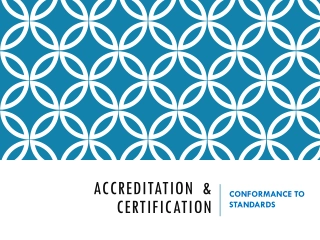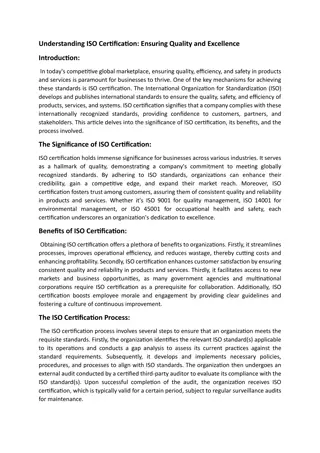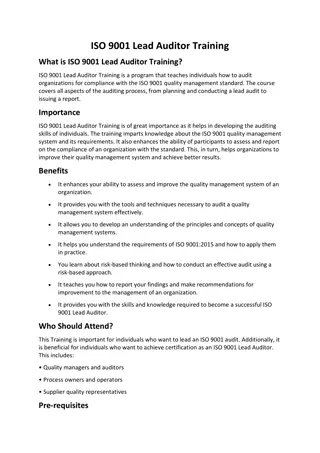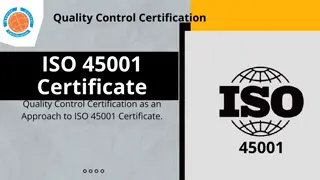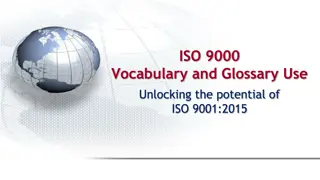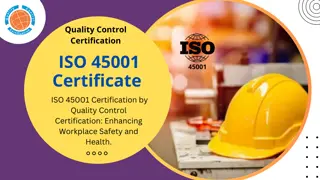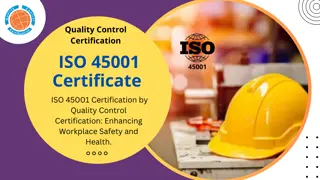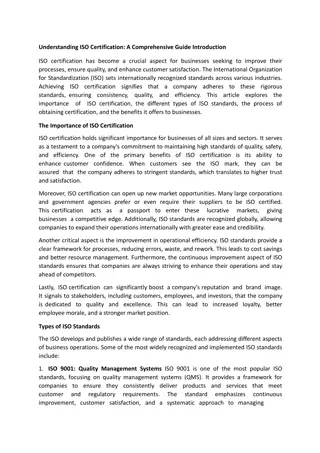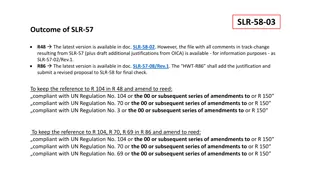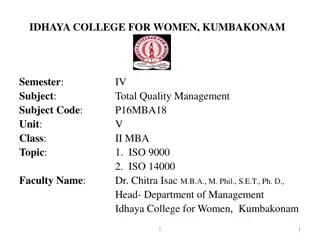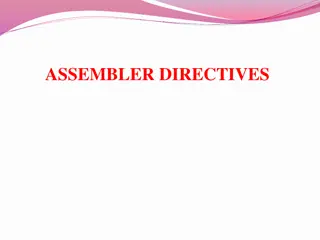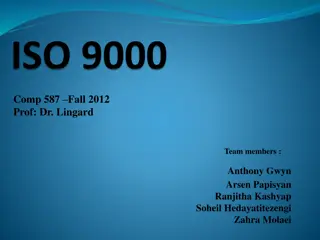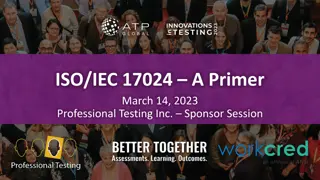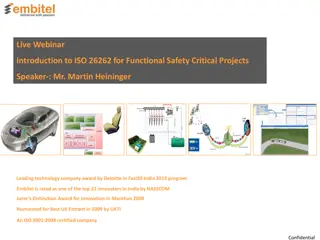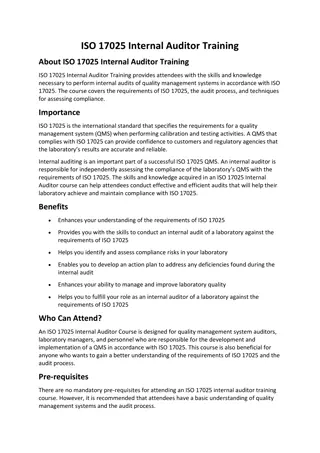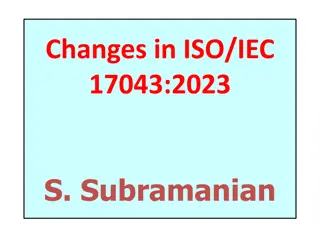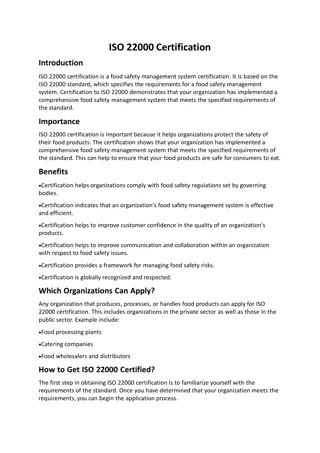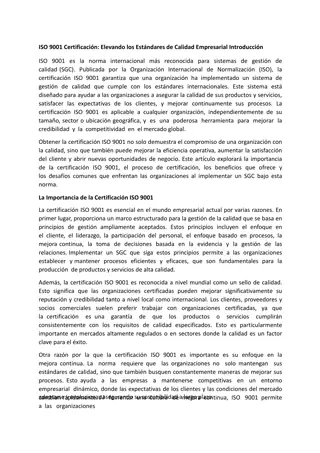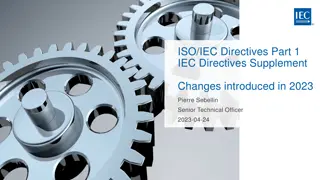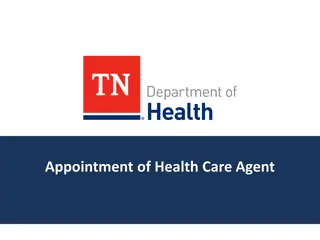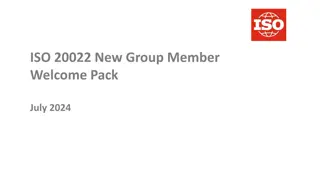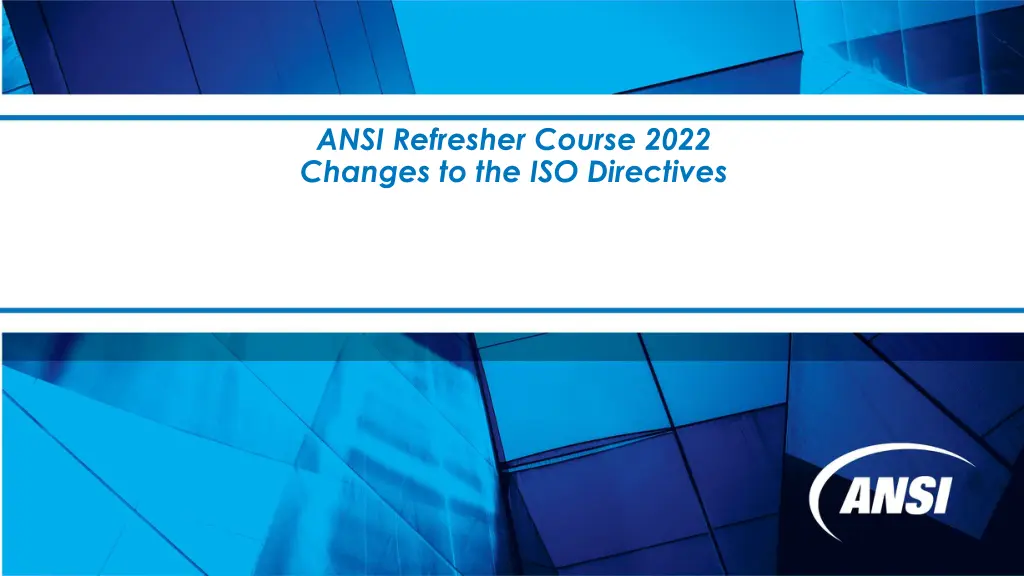
2022 Changes to ISO Directives: What You Need to Know
Stay updated with the latest changes to the ISO Directives in 2022 through this refresher course, ensuring compliance and understanding of new processes and procedures introduced each year. Learn about adjustments to voting practices, terminology updates, and voluntary participation levels within committees.
Download Presentation

Please find below an Image/Link to download the presentation.
The content on the website is provided AS IS for your information and personal use only. It may not be sold, licensed, or shared on other websites without obtaining consent from the author. If you encounter any issues during the download, it is possible that the publisher has removed the file from their server.
You are allowed to download the files provided on this website for personal or commercial use, subject to the condition that they are used lawfully. All files are the property of their respective owners.
The content on the website is provided AS IS for your information and personal use only. It may not be sold, licensed, or shared on other websites without obtaining consent from the author.
E N D
Presentation Transcript
ANSI Refresher Course 2022 Changes to the ISO Directives
Complete Registration Form You must complete the registration form after you finish this course to comply with the ANSI Executive Standards Council (ExSC) requirement for training on new changes to the ISO Directives, processes and procedures that are introduced each year.
ISO/IEC DIRECTIVES PART 1 FOREWORD, CLAUSE C) DISCIPLINE WHAT S NEW? The following text has been added to help ensure that participating members of a committee do not simply vote approval on ballots when they lack national consensus or expertise: National Bodies are encouraged to abstain if there is a lack of national consensus or Expert input on a specific ballot. WHAT DOES THIS MEAN FOR COMMITTEE CHAIRS, MANAGERS AND CONVENORS? Committee managers should monitor participation/voting and understand the reasons for abstentions from their participating members. WHAT DOES THIS MEAN FOR US/TAGs? US/TAGs should consider submitting abstention votes if necessary for the reasons stated above.
ISO/IEC DIRECTIVES PART 1 FOREWORD, CLAUSE I) TERMINOLOGY WHAT S NEW? The following changes to terminology have been made throughout the Directives, Part 1 to better reflect practice in ISO and to align with IEC: Previous references to Secretary have been changed to Secretary/Committee Manager Previous references to TCs, SCs, and PCs have been changed to committee Previous references to deliverable or publication have been changed to document WHAT DOES THIS MEAN FOR COMMITTEE CHAIRS, MANAGERS AND CONVENORS? Committee leaders should recognize these changes to better understand and use the Directives, Part 1. WHAT DOES THIS MEAN FOR US/TAGs? US/TAGs and their leaders should recognize these changes to better understand and use the Directives, Part 1.
ISO/IEC DIRECTIVES PART 1 CLAUSE 1.7.3, PARTICIPATION IN COMMITTEES WHAT S NEW? The following text has been added to encourage participating members to downgrade their level of participating voluntarily rather than have disciplinary action taken by the committee leadership and ISO/CS to downgrade them for not complying with the requirements of Clause 1.7.4: Furthermore, a P-member may voluntarily downgrade to O-member if it consistently lacks expertise for votes at the committee level or to participate in working groups. WHAT DOES THIS MEAN FOR COMMITTEE CHAIRS, MANAGERS AND CONVENORS? Committee managers shall monitor participation and inform their TPMs if a participating member is persistently inactive. WHAT DOES THIS MEAN FOR US/TAGs? US/TAGs may choose to downgrade their participating level if appropriate.
ISO/IEC DIRECTIVES PART 1 CLAUSE 1.7.4, MAINTAINING ACTIVE PARTICIPATION WHAT S NEW? Refinements have been made to the text to clarify the conditions under which a member of a committee may be assessed to be active or inactive. WHAT DOES THIS MEAN FOR COMMITTEE CHAIRS, MANAGERS AND CONVENORS? Committee managers shall monitor participation and inform their TPMs if a participating member is persistently inactive. WHAT DOES THIS MEAN FOR US/TAGs? US/TAGs shall ensure that ANSI participation does not become perceived as persistently inactive.
ISO/IEC DIRECTIVES PART 1 CLAUSE 1.8.1, APPOINTMENT OF COMMITTEE CHAIRS WHAT S NEW? While technical committees still take consensus decisions on the appointment of subcommittee chairs, candidates for a technical committee or project committee chair are decisions of the NSB holding the committee secretariat, subject to approval of the ISO/TMB. Nevertheless, text has been added to this clause to suggest that secretariats may inform, if they wish, the technical committee or project committee members of the candidates being advanced for ISO/TMB approval. The sharing of such information is not to be considered an opportunity for the TC or PC members to take a decision on the candidate or to suggest alternative candidates. WHAT DOES THIS MEAN FOR COMMITTEE CHAIRS, MANAGERS AND CONVENORS? Committee chairs and managers shall decide on whether they wish to inform the committee members of a TC or PC chair candidate. WHAT DOES THIS MEAN FOR US/TAGs? US/TAGs should work with and support candidates being advanced by ANSI-held secretariats.
ISO/IEC DIRECTIVES PART 1 CLAUSE 1.12.1, REPLACING WORKING GROUP CONVENORS WHAT S NEW? The second sentence below has been added to this clause to clarify what should occur in cases where it is necessary to replace a WG convenor: Responsibility for any changes of Convenors rests with the committee and not with the National Body (or liaison organization). In a case a WG Convenor resigns, the Secretary/Committee Manager shall launch a call to identify new candidates. WHAT DOES THIS MEAN FOR COMMITTEE CHAIRS, MANAGERS AND CONVENORS? Committee managers shall issue calls for candidates for new WG convenors when necessary. WHAT DOES THIS MEAN FOR US/TAGs? US/TAGs should consider whether they wish to advance a US person as a candidate to assume a WG convenor role.
ISO/IEC DIRECTIVES PART 1 CLAUSE 1.12.6, JOINT WORKING GROUPS WHAT S NEW? A number of changes have been made to the text to make the operations of JWGs more effective and less contentious by making both committees involved co-equals in the leadership, planning and operations of the JWG and its tasks. The role of the lead committee has been clarified to indicate that it is administrative lead and does not impart on any one committee involved a superior role in the JWG and its operations. WHAT DOES THIS MEAN FOR COMMITTEE CHAIRS, MANAGERS AND CONVENORS? Committee leaders shall ensure that JWGs are established and operate consistent with the expectations in this clause and with full respect for both committees involved. WHAT DOES THIS MEAN FOR US/TAGs? US/TAGs should consider whether they wish to have US experts participate in a JWG.
ISO/IEC DIRECTIVES PART 1 CLAUSE 1.13, ADVISORY GROUPS WITHIN A COMMITTEE WHAT S NEW? The following text has been added to this clause: Members of advisory groups may include committee officers, individuals nominated by National Bodies (either individuals representing their own Expert opinion or individuals representing the interests of their National Body) and representatives of liaison organizations. The committee shall approve the appointment of the Convenor, type of membership and the terms of reference prior to the establishment of the advisory group and nominations to it. The parent committee shall also approve the disbanding of an advisory group. WHAT DOES THIS MEAN FOR COMMITTEE CHAIRS, MANAGERS AND CONVENORS? Committee chairs and managers shall establish advisory groups consistent with the provisions of this clause. WHAT DOES THIS MEAN FOR US/TAGs? US/TAGs shall consider approving proposals for advisory groups, whether the US should participate in them, and who the US representative will be.
ISO/IEC DIRECTIVES PART 1 CLAUSE 1.14, AD HOC GROUPS WITHIN A COMMITTEE WHAT S NEW? The following text has been added to this clause: Members of ad hoc groups may include committee officers, individuals nominated by National Bodies (as appropriate, either individuals representing their own Expert opinion or individuals representing the interests of their National Body) and representatives of liaison organizations. The committee shall approve the appointment of the Convenor, type of membership, terms of reference and target date for completion of the work prior to the establishment of the ad hoc group and nominations to it. The committee shall disband the ad hoc group when it has completed its work. WHAT DOES THIS MEAN FOR COMMITTEE CHAIRS, MANAGERS AND CONVENORS? Committee chairs and managers shall establish ad hoc groups consistent with the provisions of this clause. WHAT DOES THIS MEAN FOR US/TAGs? US/TAGs shall consider approving proposals for ad hoc groups, whether the US should participate in them, and who the US representative will be.
ISO/IEC DIRECTIVES PART 1 CLAUSE 1.16.2, LIAISONS BETWEEN COMMITTEES WHAT S NEW? The following new text has been added to this clause to clarify the role of an ISO committee liaison representative to another committee to represent the perspective of the committee he or she represents and not their individual, employer or national perspectives: They may also attend meetings of working groups of the technical committee or subcommittee, but only to contribute the viewpoint of their own committee on matters within its competence. WHAT DOES THIS MEAN FOR COMMITTEE CHAIRS, MANAGERS AND CONVENORS? Committee leaders shall ensure that their liaison representatives to other committees conduct themselves consistent with this clause. WHAT DOES THIS MEAN FOR US/TAGs? US/TAGs may wish to consider whether a US person should be advanced to serve as a committee liaison.
ISO/IEC DIRECTIVES PART 1 CLAUSE 2.1.6.2, AUTOMATIC CANCELLATION OF PROJECTS WHAT S NEW? If the limit date for DIS or publication is exceeded, the committee shall decide within 6 months on a number of possible suggested actions in this clause for advancing the project. The following new text has been added to this clause: If, at the end of the six-month period, none of the above actions has been taken, the project shall be automatically cancelled by the ISO Central Secretariat. Such projects may only be reinstated with the approval of the committee (NP ballot or committee resolution). WHAT DOES THIS MEAN FOR COMMITTEE CHAIRS, MANAGERS AND CONVENORS? Committee leaders shall ensure that their projects meet their limit dates or they shall make decisions within the six months allowed in order to advance a project that has exceeded limit dates. WHAT DOES THIS MEAN FOR US/TAGs? No direction actions or impact on US/TAGs.
ISO/IEC DIRECTIVES PART 1 CLAUSE 2.3.1, PROPOSALS FOR TSs AND PASs WHAT S NEW? Text has been added to this clause to clarify that: The NP stage is not needed to convert a PAS into a TS For approval of proposals not requiring an NP vote and form, the committee shall pass a resolution approving the project that captures the scope, target dates, WG convenor or project leader, relevant UN SDGs, and the committee manager will issue a call for WG experts A two-thirds consensus is needed for decisions to convert a TS or PAS into an IS, convert a PAS into a TS, and to approve any revision or amendment that expands the scope of the project The committee manager shall ensure that any new project has the required 4 or 5 participating members actively engaged. WHAT DOES THIS MEAN FOR COMMITTEE CHAIRS, MANAGERS AND CONVENORS? Committee managers shall implement the provisions of this clause in relation to proposals for new work or conversion of existing projects. WHAT DOES THIS MEANS FOR US/TAGs? US/TAGs shall take appropriate decisions on the approval of proposals for new work or conversion of existing projects.
ISO/IEC DIRECTIVES PART 1 CLAUSE 2.4.5, REPORTING LINES OF PROJECT LEADERS WHAT S NEW? The following text has been added to this clause to clarify the report lines of project leaders: The Project Leader is responsible for the development of the project and will normally convene and chair any meetings of the working group related to the project. For projects registered directly under the committee, the Project Leader reports to the committee officers. For projects registered under a WG, the Project Leader reports to the Convenor of the WG. Work continues until consensus is reached on the proposed text. The Project Leader may invite a member of the working group to act as its Secretary. WHAT DOES THIS MEAN FOR COMMITTEE CHAIRS, MANAGERS AND CONVENORS? Committee managers and WG convenors shall conduct their work consistent with this clause. WHAT DOES THIS MEAN FOR US/TAGs? No direct action or impact for US/TAGs.
ISO/IEC DIRECTIVES PART 1 CLAUSE 2.5, COMMITTEE DRAFT STAGE WHAT S NEW Text has been revised to clarify that: Discussion of comments received on a CD should be addressed by the appropriate WG for the project While the CD is still optional in ISO (as decided by the committee), voting is no longer an option on the circulation of a CD, which will be circulated for comments only to align with practice in IEC and JTC1 A decision on whether to advance the CD to the DIS stage will be made by the committee chair in consultation with the committee manager and the appropriate WG convenor and project leader based on the CD comments received When the committee chair s decision is circulated to the committee members, if two or more committee members object to the committee chair s decision, the issue will be discussed and decided by CIB or at the next meeting Consideration of successive CDs shall be based on resolving comments received and not considered an opportunity to submit and consider new comments If there is any doubt on consensus to advance a CD to DIS, a two-thirds majority of the committee participating members will be considered as consensus WHAT THIS MEANS FOR COMMITTEE CHAIRS, MANAGERS AND CONVENORS Committee chairs and managers shall advance consideration of CDs consistent with the provisions of this clause. WHAT THIS MEANS FOR US/TAGs US/TAGs shall take decisions on comments to submit on CDs and on whether to support the committee chair s decision on whether to advance the CD to DIS.
ISO/IEC DIRECTIVES PART 1 CLAUSE 2.6.4, ACTIONS FOLLOWING A DIS VOTE WHAT S NEW? Text has been revised to clarify that: An appropriate group of the committee, which would typically be the working group to which the project is assigned, will at a meeting address any comments received on the DIS, prepare as needed a revised version, and advise the committee chair on possible courses of action A revised or second DIS is possible after a successful DIS vote if the appropriate group makes substantive changes based on consideration of the comments and the group recommends a second DIS vote A project may be advanced as a draft TS or PAS for voting if approval for an IS cannot be achieved. WHAT DOES THIS MEAN FOR COMMITTEE CHAIRS, MANAGERS AND CONVENORS? Committee chairs and managers shall implement decisions following a DIS vote consistent with this clause. WHAT DOES THIS MEAN FOR US/TAGs? US/TAGs shall take decisions on DISs and on whether to support the option presented for advancing the project following a DIS vote.
ISO/IEC DIRECTIVES PART 1 CLAUSE 2.9, MAINTENANCE OF DOCUMENTS WHAT S NEW? Changes that update or editorially improve a standard without changing the technical content are considered minor changes. Text has been revised to clarify that approval of a minor change only requires a proposal to the committee using Form 21 after a systematic review or via a committee decision and completion of Form 8B. In case a revision project is abandoned by the committee before reaching publication, the stage of the published standard will be reverted to the previous stage and the next systematic review ballot will be based on the date the previous stage had been reached. WHAT DOES THIS MEAN FOR COMMITTEE CHAIRS, MANAGERS AND CONVENORS? Committee chairs and managers shall implement decisions on the ongoing maintenance of documents consistent with this clause. WHAT DOES THIS MEAN FOR US/TAGs? US/TAGs shall take decisions on the ongoing maintenance of documents in the committee.
ISO/IEC DIRECTIVES PART 1 CLAUSE 2.10.3, AMENDMENTS WHAT S NEW? Before the approval stage, rather than publish an amendment, the committee in consultation with ISO/CS may decide on whether to ballot and publish a revised standard incorporating an amendment, bearing in mind the financial consequences and the needs of users of the standard. No more than 2 separate amendments may be issued for an ISO standard. A possible third amendment will initiate a full revision of the standard that incorporates all amendments. WHAT DOES THIS MEAN FOR COMMITTEE CHAIRS, MANAGERS AND CONVENORS? Committee chairs and managers shall implement amendments consistent with the provisions of this clause. WHAT DOES THIS MEAN FOR US/TAGs? US/TAGs shall take decisions on proposals for amendments.
ISO/IEC DIRECTIVES PART 1 CLAUSE 3.1, 3.2 AND 3.3, TECHNICAL SPECIFICATIONS, PUBLICLY AVAILABLE SPECIFICATIONS AND TECHNICAL REPORTS WHAT S NEW? The text of all three clauses has been substantially revised to clarify the processes for the introduction, development and approval of TSs, PASs and TRs and to align the presentation of information in these clauses Committees may choose to use an optional CD stage for TSs and PASs Second DTSs and DPASs are possible based on how comments on the first DTS or DPAS were handled A decision to introduce a PAS project requires a simple majority vote of the ISO committee. PASs may not complete with an existing IS, but multiple competing PASs on the same subject may occur An NP ballot is not required for approval of a PAS, but may be used if that is considered helpful WHAT DOES THIS MEAN FOR COMMITTEE CHAIRS, MANAGERS AND CONVENORS? Committee leaders shall implement the development of TSs, PASs and TRs consistent with these clauses. WHAT DOES THIS MEAN FOR US/TAGs? US/TAGs shall take positions on proposals for TSs, PASs and TRs.
ISO/IEC DIRECTIVES PART 1 FORMS WHAT S NEW? Revisions have been made to the following ISO Forms to clarify and simplify them: Form 1 (Proposal for a new field of ISO technical work) Form 4 (New work item proposal) Form 6 (Results of voting on a new work item proposal) Furthermore, the online interface for responses on CDs has been revised to reflect that CDs will only be issued for comments and not votes in the future WHAT DOES THIS MEAN FOR COMMITTEE CHAIRS, MANAGERS AND CONVENORS? Committee managers shall ensure that the most up-to-date forms are used for the work of the committee. WHAT DOES THIS MEAN FOR US/TAGs? US/TAGs wishing to propose a new work item proposal shall develop such a proposal using the new Form 4. US/TAGs shall also provide their comments on CDs in order for ANSI to submit them online.
For Questions For questions on the content of this course, please contact Steve Cornish at scornish@ansi.org or 1-212-642-4969 For questions regarding compliance requirements for this course, please contact Sara Desautels at sdesautels@ansi.org or 1-212-642-4937
Course Completion Compliance Instructions After completing this course, you must send an email confirming its completion to comply with the ANSI Executive Standards Council requirement for training on new changes to the ISO Directives, processes, and procedures that are introduced each year. Please send an email to ANSI's ISO Team via this link confirming you've completed the course and including the following information: Name Email address ISO Committee or U.S. TAG Role (ISO Committee Manager or Chair, U.S. TAG Administrator or Chair) If you have questions or need any assistance, please email isot@ansi.org.

